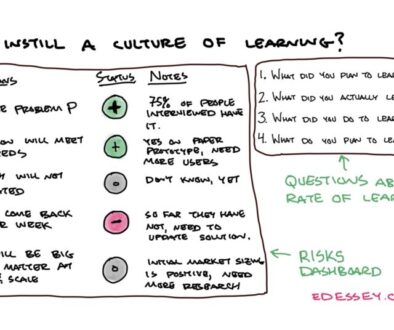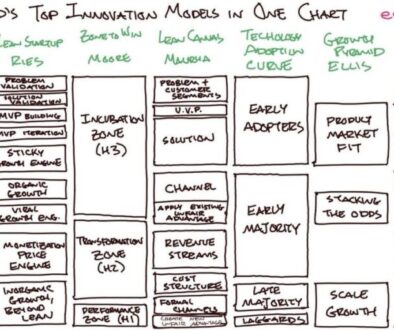Ambidexterity: Zone to Create Breakthroughs and Growth
An ideal organization can create breakthrough new businesses and grow existing ones. This is called an ambidextrous organization (Robert Duncan, 1976).
By definition, ambidextrous organizations achieve breakthrough innovations while relentlessly improving execution of the current business model.

Developing organizational ambidexterity increases performance, especially “under conditions of market and technological uncertainty” (see O’Reilly and Tushman’s document). For fans of Eric Ries, our ears perk up, because we know the lean startup method also excels under conditions of extreme uncertainty. So, it’s especially potent to combine these two ideas for innovation within an enterprise.
Since the term was introduced, there have been many studies and theories on how to create an ambidextrous organization. My favorite is Geoffrey Moore’s Zone to Win model, which I mentioned in How to Create Innovation Pathways.
Here’s a primer on the zone to win method and you can fit it into your firm.
Quick Primer on the Zones
If you run an innovation program, Zone to Win is a must-read. It transcends the simple concept of organizational ambidexterity by covering how to organize the entire company and transition projects from one hand to the other.
To do this, establish these zones in the company: a performance zone, productivity zone, incubation zone, and when needed, a transformation zone.

First, let’s begin where new ideas take seed.
Incubation Zone
The incubation zone is for potential future businesses, which is sometimes known as horizon 3 innovation.
When you create this zone, you need it to provide all of the support that new businesses need to operate quickly and test whether their new models will work. It is difficult to borrow resources from the productivity zone or performance zone, because eventually horizon 1 needs with beckon. Then, the incubation zone gets deprioritized. Since the existing businesses keep everyone running, this is the right thing to do.
By that same reasoning, you need to also ensure that the incubation zone does not threaten the existing businesses. You want it to provide benefits for future businesses, not endanger the core businesses.
Rather than being seen as a risk, the incubation zone can be seen as insurance, if positioned well. In times of risk to the performance zone, you can harvest ideas of the incubation zone to retain or regain a leadership position.
In times of dominance in the existing businesses, this is the area to nurture new growth businesses. Ideally, the incubation zone can eventually nurture businesses that generate substantive new impact or revenue for your company.
That’s when you need to rezone that business idea.
Transformation Zone
A company creates a transformation zone when a new business shows the right traction to become horizon 2.
According to Moore, a transformation zone doesn’t exist most of the time, it is created only when a business is ready. And it’s created specifically to grow this one business into the performance zone.
When the timing is right, bring the budding new business out of the incubation zone and give it full support from across the company. True to the name, the purpose of the transformation zone is to transform both that business and that company to bring the new business into the performance zone as quickly as possible.
Performance Zone
The performance zone is for the work that makes the majority of the revenue for the company. Moore’s rule of thumb is that this is for business lines with 10% or more of the company’s revenue.
Horizon 1 innovation happens in this zone to keep these businesses earning money. It’s imperative that the company defends and continues to grow these businesses through sustaining innovation.
And to give it it’s best shot, most companies already have another zone to increase the productivity of the performance zone.
Productivity Zone
The productivity zone contains the support functions for keeping the performance zone operational. These are things like Finance, HR, legal, and other support functions that aren’t directly creating the product.
With the productivity zone well established, the company can reap the benefits of its existing horizon 1 innovation.
Benefits
The benefit of this model is an ambidextrous organization that can maximize performance, incubate a broad portfolio, and transition between the two states rapidly.
When companies successfully transition a new business into the performance zone, this usually results in a huge leap in-market results. It may be very difficult to do, but well worth it!
For instance, at Microsoft, where I work, Azure is often given as the most recent example of a transition into the performance zone.
During the time Azure within the Transformation Zone, our CEO at the time was Steve Ballmer. He was instrumental in ensuring in establishing the transformation zone and ensuring that Azure got what it needed to be successful.
He repeatedly told the company that we were “all in” on Azure. A huge swath of the productivity zone was invested in making this so. Training programs were created across the company to show the company how to move from a products mentality to a services mentality. Large businesses reorganized to support this change. Many existing businesses in the performance zone were built on Azure.
This transitioned Azure to the Performance Zone swiftly. He reorganized much of the company around this. This is the kind of thing your company will need to do, from the CEO down.
Summary
The mainstay of the business consultant is to create an awesome 2×2 matrix, and Geoffrey Moore provides one. Looking at it from this perspective, creates an easy to remember summary.
The rows are revenue performance and enabling investments. And the columns are disruptive innovations and sustaining innovations.

The incubation zone consists of enabling investments to create disruptive innovations.
Then the transformation zone focuses on growing revenue performance from those disruptive innovations.
With performance zone being about ensuring the revenue performance of the sustaining innovations.
The productivity zone is about enabling investments in the sustaining innovations of the performance zone.
In future posts, I’ll cover how you can set up operationalize an incubation zone in your company.
***
This week is the Lean Startup Conference. It’s your going, please let me know. I hope to see you there.
This article is part of my upcoming workshop at the conference. It’s on October 23, 2019, in San Francisco, where entrepreneurs and innovators from around the world will be gathering to discuss the latest innovations in modern management.
It’s pretty last minute, but if you can make it, you can use the code “Essey2019” for a discount on registration.
If you found this helpful
If you found this useful, I’d appreciate it if you would:
- Subscribe to receive the follow-ups.
- Share if you know someone who can use this.
- Comment with questions and stories, so that others can benefit from your thoughts.
We’re all in this together!




The World's Top Innovation Models in One Chart - Ed Essey
May 15, 2020 @ 5:13 am
[…] Zone to Win by Geoffrey Moore, which I’ve covered in previous posts like Ambidexterity: Zone to Create Breakthroughs and Growth. […]
May 29, 2020 @ 5:48 pm
Like!! Thank you for publishing this awesome article.
June 3, 2020 @ 1:30 am
Sweet blog! I found it while searching on Yahoo News. Do you have any suggestions on how to get listed in Yahoo News? I’ve been trying for a while but I never seem to get there! Thank you